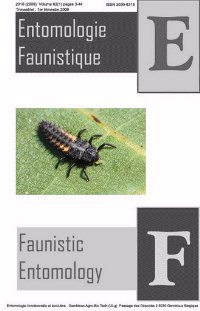- Startpagina tijdschrift
- Volume 67 (2014)
- Biogéographie des coccinelles (Coleoptera: Coccinellidae) d’Algérie
Weergave(s): 1621 (12 ULiège)
Download(s): 4949 (13 ULiège)
Biogéographie des coccinelles (Coleoptera: Coccinellidae) d’Algérie

Résumé
Trente-quatre stations réparties à travers huit secteurs géographiques de l’Algérie furent périodiquement échantillonnées durant quatre années successives (2003 – 2007). Des analyses multivariées (ordination et classification) permirent d'étudier la variabilité de la structure des communautés des coccinelles identifiées. Au total 48 taxons représentant 12 tribus et 22 genres ont été inventoriés. Il ressort clairement de cette étude que la quasi-totalité de la faune des coccinelles d’Algérie se rattache à la région paléarctique, et ce, malgré le climat aride et saharien qui caractérise la plus grande partie de ce pays. Le domaine maghrébin du Tell méridional qui constitue l’extrême Nord de l’Algérie est le plus peuplé en coccinelles avec 41 espèces. En revanche, le domaine saharo méditerranéen, constitué par le grand désert, est le moins peuplé. 16 espèces vivent dans le Sahara septentrional, 10 dans le Sahara central et 5 seulement dans le Sahara méridional. Cette partie de l’Algérie se caractérise également par la présence de 6 espèces non encore signalées en Afrique du Nord: Pharoscymnus ovoideus (Sicard, 1929), Pharoscymnus numidicus (Pic, 1900), Exochomus nigripennis (Erichson, 1843), Exochomus (Parexochomus) pubescens forme apicalis (Weise, 1885), Hyperaspis marmottani (Fairmaire, 1868), ainsi qu'un minuscule Scymnus (Pullus) sp. non encore identifié. L’analyse de la distribution des coccinelles dans les secteurs géographiques montre que les espèces: Coccinella septempunctata (Linné, 1758), Hippodamia (Adonia) variegata (Goeze 1777), Stethorus punctillum (Weise 1891), et Henosepilachna argus (Goeffroy 1762), présentent une large plasticité écologique. Elles sont présentes dans toutes les régions d'Algérie et s’adaptent à tous les climats.
Abstract
Thirty-four stations spread across eight geographic regions of Algeria were periodically sampled for four successive years (2003 –2007). Multivariate analysis (ordination and classification) allowed to study the variability of community structure of ladybird. 48 taxa representing 12 tribes and 22 genera have been inventoried. It is clear from this study that almost all of the fauna of beetles from Algeria is linked to that of the Palaearctic region, and despite the arid and Saharan characterizes much of this country. The southern area of the Tell Maghreb, which is the extreme northern Algeria, is the most populous in ladybugs. In the Algiers area 41 taxa were identified, 36 and 28 in Oran in the Numidian. However, the field Saharo - Mediterranean, comprising the great desert, is the least populated. 16 species live in the northern Sahara, 10 in the central Sahara and 5 only in the southern Sahara. This part of Algeria is also characterized by the presence sexes species not previously reported in North Africa, they live in the northern Sahara.They are: Pharoscymnus ovoideus (Sicard, 1929), Pharoscymnus numidicus (Pic, 1900), Exochomus nigripennis (Erichson, 1843), Exochomus (Parexochomus) pubescens forme apicalis (Weise, 1885), Hyperaspis marmottani (Fairmaire, 1868), and that a tiny Scymnus (Pullus) sp. unidentified. The low number of species recorded from that constituting the fauna of beetles of Europe is explained by the fact that Algeria is isolated by barriers both sea and desert that prevent the spread of these beetles. The analysis of the distribution of beetles in each of the different geographical areas shows that Coccinella septempunctata (Linné, 1758), Hippodamia (Adonia) variegata (Goeze 1777), Stethorus punctillum (Weise 1891), et Henosepilachna argus (Goeffroy 1762), have a broad ecological plasticity. They are present in all regions of Algeria and fit all climates.






